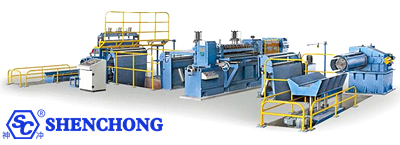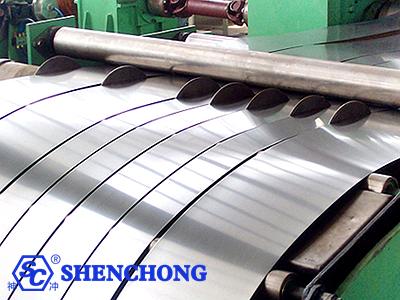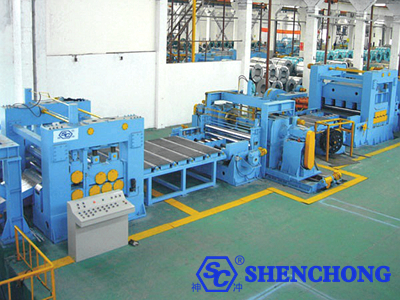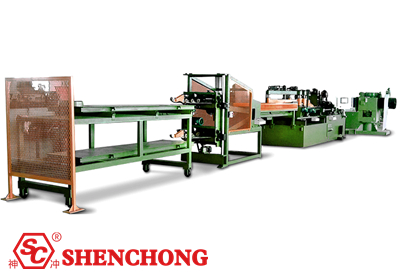
In the production line, sheet metal slitting line and transverse cutting line are equipment that cut raw materials longitudinally and transversely according to the actual needs of customers to prepare materials for subsequent forming processes.
The materials after slitting are generally used for continuous production. Such as: automatic punching, rolling, secondary slitting or cross-cut processing, etc. The transverse-cut material is generally subsequently used for single molding processing. Such as: sheet metal stamping, bending, stretch forming, etc.

Sheet metal slitting line is suitable for longitudinal cutting of metal strips and rewinding the cut narrow strips into rolls. Easy to operate. Cutting quality is high. High material utilization rate. The cutting speed can be adjusted steplessly.
The slitting production line is also called slitting unit, steel coil slitting machine and shears. It is mainly used for slitting tinplate, galvanized iron, silicon steel sheets, cold-rolled strips, stainless steel strips, aluminum strips, thin steel strips and other coil materials. It cuts metal coils into strips of various required widths, and then collects the strips into small rolls for use in the next process.
- According to the thickness of the slitting plate, it is divided into thin plate slitting line (processing thickness 0.1-3.0mm) and thick plate slitting line (processing thickness 3.0-6.0mm).
- According to the slitting metal material, it is divided into copper strip slitting line, stainless steel slitting line, cold plate slitting line, silicon steel slitting line and tinplate slitting line.
- According to the degree of automation, it is divided into fully automatic slitting line and semi-automatic slitting line.
The two blades of this shear are parallel to each other. It is usually used to transversely shear bloom billets (square, slab) and other square and rectangular cross-section steel billets, so it is also called billet cutting machine.
This type of cutting machine sometimes also uses two forming blades to cold shear rolled parts (such as round tube blanks and small round steel, etc.). At this time, the shape of the blade is adapted to the cross-sectional shape of the sheared and rolled piece.
The upper blade of this cutter is inclined and the lower blade is horizontal. The upper and lower blades are positioned at a certain angle to each other. The inclination of the upper blade is 1° to 6°. This kind of cutting machine is commonly used for cold cutting and hot cutting of steel plates, strips, thin slabs and welded pipe blanks. Sometimes it is also used to cut small steel products in bundles.
When rolling hollow window material, an inclined blade shear is often used to cut the head and tail of the strip (when the strip is not cut at the head and tail) for welding into large coils of strip.
Inclined blade shears make the upper blade slanted and the lower blade horizontal. Its purpose is to reduce the shear contact length with the sheared piece, thereby reducing the cutting force, reducing the size of the cutting machine, and simplifying the structure.
The main parameters of the oblique blade cutting machine are maximum cutting force, blade inclination angle, blade length and number of shears. These parameters are determined based on the dimensions and mechanical properties of the rolled piece.

Slitting lines are mainly suitable for transformers, motors, home appliances, automobiles, building materials, packaging industries, etc.
Process flow: Winding → Uncoiling → Heading → Pinch-feeding and rough straightening → Cutting → Scrap collection → Swing bridge → Deviation correction and feeding → Slitting → Scrap edge coiling → Swing bridge → Tension station → Rewinding → Unloading
Technical parameters and equipment configuration can be determined according to customer needs
Parameter Model | Thicknes (mm) | Width (mm) | Number of slitting strips | Slitting speed (m/min) | Uncoiling weight (ton) |
ESL-0.5x1300 | 0.15-0.5 | 500-1300 | 24 | 50-150 | 7 |
ESL-2x1300 | 0.3-2 | 500-1300 | 12-30 | 50-180 | 7/15 |
ESL-2x1600 | 0.3-2 | 500-1600 | 12-30 | 50-180 | 7/15 |
ESL-3x1600 | 0.3-3 | 500-1600 | 8-30 | 50-180 | 15 |
ESL-3x1800 | 0.3-3 | 900-1800 | 8-30 | 50-180 | 20 |
ESL-4x1600 | 1-4 | 900-1600 | 6-30 | 50-120 | 20 |
ESL-6x1600 | 1-6 | 900-1600 | 6-30 | 30-80 | 30 |
ESL-12x1600 | 2-12 | 900-1600 | 5-30 | 20-50 | 30 |
The slitting production line generally has the function of rewinding all the raw materials after being slit. Therefore, compared with the transverse cutting line, the sheet metal slitting line generally has the width of 1000-1250mm, the thickness of 0.2-0.5mm, and the plate strength σs<300MPa. The load-bearing capacity is less than 5 tons, and the production speed is about 80-120m/min. The rewinding and unwinding adopt hydraulic or pneumatic and other auxiliary equipment.

The cross-cutting line is used to uncoil, level, cut the metal coils into flat sheets of the required length and stack them. Sheet metal transverse cutting line is suitable for processing cold-rolled and hot-rolled carbon steel, silicon steel, tinplate, stainless steel and various metal materials with surface coating and cross-cutting operations.
- According to the thickness of the transverse cut, it is divided into thin plate transverse shear line (processing thickness 0.1-3.0mm) and thick plate transverse shear line (processing thickness 3.0-6.0mm).
- According to the slitting metal material, it is divided into copper strip cross-cutting line, stainless steel cross-cutting line, cold plate cross-cutting line, silicon steel cross-cutting line, and tinplate cross-cutting line.
- According to the degree of automation, it is divided into fully automatic transverse cutting line and semi-automatic cross-cutting line.

The cross-cut line production line is mainly composed of a loading trolley, an uncoiler, a leveling machine, a feeding mechanism, a shearing machine, a conveying device, a stacking device, etc.
The production line can be equipped with a slitting machine to cut the sheets into required widths, cut them into fixed lengths and stack them. The cross-cut line is a high-performance product that integrates machinery, electricity and hydraulics.
High degree of automation, simple and reliable operation. High precision in length determination, high flatness of sheets, and neat stacking.
Compared with the design of the slitting line, the transverse cutting line is obviously diversified. Not only the feeding system that matches it is changeable, but the shearing and subsequent stacking systems are also different according to different needs, and there are many combinations of each other.
The stacking device is divided into two structures: gantry stacking and open stacking:
The gantry structure is equipped with a roller device and a beating device, which can neatly stack the steel plates delivered by the conveyor roller or conveyor belt line to the conveyor flat car or hydraulic lift trolley. Equipped with pneumatic blowing and flotation system, which can effectively prevent sheet scraping.
The open structure is equipped with left and right blocking devices and a pneumatic beating device, which can stamp the steel plates transmitted by the conveyor roller or conveyor belt line onto the hydraulic lifting trolley.
Model/Parameters | Thickness (mm) | Width (mm) | Cutting accuracy (mm) | Max. cutting speed (m/min) | Max. number of cuts (spm) | Uncoiling weight (ton) |
HFCL-2*1300 | 0.2-2 | 500-1300 | ±0.3 | 60 | 50 | 7/15 |
HFCL-2*1600 | 0.2-2 | 500-1600 | ±0.3 | 60 | 50 | 7/15 |
HFCL-2*1830 | 0.2-2 | 900-1800 | ±0.3 | 50 | 40 | 20 |
HFCL-3*1600 | 0.5-3 | 500-1600 | ±0.3 | 50 | 40 | 15 |
HFCL-3*1830 | 0.5-3 | 900-1800 | ±0.3 | 50 | 40 | 20 |
HFCL-3*2000 | 0.5-3 | 900-2000 | ±0.3 | 45 | 40 | 30 |
HFCL-6*1600 | 1-6 | 900-1600 | ±1 | 25 | 20 | 20 |
HFCL-6*2000 | 1-6 | 900-2000 | ±1 | 25 | 20 | 30 |
HFCL-8*2000 | 2-8 | 900-2000 | ±1 | 20 | 20 | 30 |
HFCL-12*2000 | 3-12 | 900-2000 | ±1.5 | 20 | 10 | 30 |
HFCL-16*2000 | 4-16 | 900-2000 | ±2 | 15 | 8 | 30 |
In order to maintain the accuracy of the cross-cut line, extend its service life and ensure the safety of people and equipment, the following safety operating procedures must be strictly followed during operation:
- Wear neat work clothes.
- Before operating the equipment, you must check whether the machine tool handle and operating parts are normal.
- The materials should be clamped and clamped properly. Check whether the leveling and straightening equipment is turned on simultaneously.
- After installing the materials, measure the center positioning. Check that the hole spacing is correct.
- The speed can be changed only after the operation is paused.
- When the machine tool is running, it is strictly forbidden to touch the material with your hands. Do not touch the mold and motor with your hands.
- It is strictly prohibited to place tools, measuring tools, gloves and other items on the machine tool guide rails and molds.
- Do not leave the machine tool after the equipment is running. You need to concentrate on the operation.
- After get off work, clean the machine tools and tidy up the area. Cut off the machine power. Lubricate machine tool gears.
- During processing, if you find that the machine tool is operating abnormally or has a malfunction, the power supply should be cut off immediately. Diagnose the fault or notify the manufacturer.
Click here to know: Street Light Pole uncoiling and leveling line